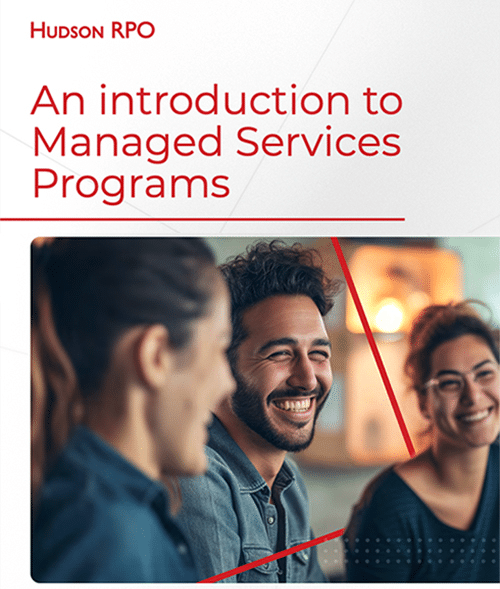- Blogs & Articles
The AI Effect: Is Your Leadership Ready for What’s Next?
Preparing the C-Suite for the Disruption Already Here
In 2025, AI is no longer a futuristic idea; it’s an operational reality. Organizations are rapidly integrating artificial intelligence (AI) into their HR and workforce strategies, with AI now touching everything from talent acquisition to employee self-service. But while technology adoption is soaring, a crucial question remains: Are your senior leaders ready to lead in this new era?
The Leadership Readiness Gap
According to the 2024–2025 HRO Today Annual Top Concerns of CHROs, nearly 45% of senior HR leaders agree that AI will be the biggest disrupter to the HR function within the next two to three years, a number that has tripled compared to those who disagreed (14%) source: HRO Today Annual CHRO Survey, sponsored by Hudson RPO. In EMEA, agreement climbs even higher to 55%, signaling increasing urgency across regions.
Yet despite these concerns, only 41% of North American leaders feel prepared to lead their organizations into this AI-driven future, compared to 53% in EMEA. This reveals a significant leadership readiness gap just as AI disruption accelerates.
The 2024 AI Adoption Surge
In 2024, AI usage in HR jumped dramatically. 65% of HR departments globally reported using AI, up from 40% the previous year. This spike in adoption mirrors broader business trends, as McKinsey reports AI integration across functions rose from 55% to 72% globally in 2024 according to McKinsey 2024 Global AI Survey (pg 15).
Top applications of AI in HR include talent acquisition (64%), where tools like resume analysis algorithms and AI-powered psychometric tests are used to streamline hiring; workforce analytics (53%), supporting predictive modeling for attrition and skill gaps; and employee self-service (31%), which leverages AI chatbots and automated support systems to enhance HR responsiveness according to the 2024–2025 HRO Today Annual Top Concerns of CHROs, sponsored by Hudson RPO.
Despite its benefits, AI also raises strategic and ethical questions around workforce planning, job displacement, and reskilling. Without AI fluency at the leadership level, companies risk falling behind in innovation and failing to support their people through change.
What Does Future-Ready Leadership Look Like?
AI is not just an IT initiative—it’s a leadership challenge. And the skills required to navigate this disruption are evolving:
Key Traits of Future-Ready Leaders:
- Digital Fluency – Understanding AI, data ethics, and how technologies reshape job roles
- Agility – Leading through constant disruption, market volatility, and talent shifts
- Change Enablement – Communicating vision, guiding transformation, and reskilling teams
- People-First Thinking – Balancing efficiency with empathy in tech-driven environments
According to the CHRO study, leader and manager effectiveness remains a top concern, cited by 59% in EMEA and 48% in North America. As AI automates tasks and rewrites job descriptions, leaders must redefine how value is created and how human potential is unlocked.
AI Is Reshaping Jobs—Fast
The International Monetary Fund (IMF) projects that AI will impact nearly 40% of jobs globally, and up to 60% in advanced economies according to the IMF AI and Jobs Report, 2024. While some roles may be displaced, many will be augmented—requiring new leadership approaches to talent development, role design, and cross-functional collaboration.
HR leaders, especially those in L&D and talent management, are uniquely positioned to drive this evolution. But doing so requires buy-in from the top—and that means closing the AI fluency gap among executives.
Regional Divergences in Readiness
The CHRO report also points to regional disparities in preparedness and adoption:
| Region |
AI Adoption (HR) |
Believe AI Will Be HR’s Biggest Disrupter |
Senior Leaders Prepared |
|---|---|---|---|
| North America | 64% | 42% | 41% |
| EMEA | 69% | 55% | 53% |
In EMEA, concerns about implementing HR tech (48%) and budget constraints (55%) are significantly higher than in North America. Yet despite the challenges, they also report higher investment in internal training and leadership development—suggesting a more proactive approach to future proofing.
Why It Matters Now
The conversation around AI is no longer hypothetical. Leadership readiness is now a business imperative. Organizations that fail to build AI-capable leadership teams may find themselves struggling to adapt, innovate, or compete in a landscape defined by rapid automation and shifting workforce dynamics.
What Hudson RPO Recommends
Hudson RPO is helping organizations turn this disruption into opportunity with tailored solutions that include:
- Leadership Development Programs to build AI awareness and digital strategy capabilities
- Workforce Planning with AI-Enabled Talent Insights
- Global Employer Branding that resonates in tech-forward, talent-tight markets
- Custom Talent Pipelines built with agility and upskilling in mind
Empower Your Leaders for the AI Era

Hudson RPO
Content Team
The Hudson RPO Content Team is made up of experts within the Talent Acquisition industry across the Americas, EMEA and APAC regions. They provide educational and critical business insights in the form of research reports, articles, news, videos, podcasts, and more. The team ensures high-quality content that helps all readers make talent decisions with confidence.
Sign up to receive the latest recruitment insights and Hudson RPO news.





